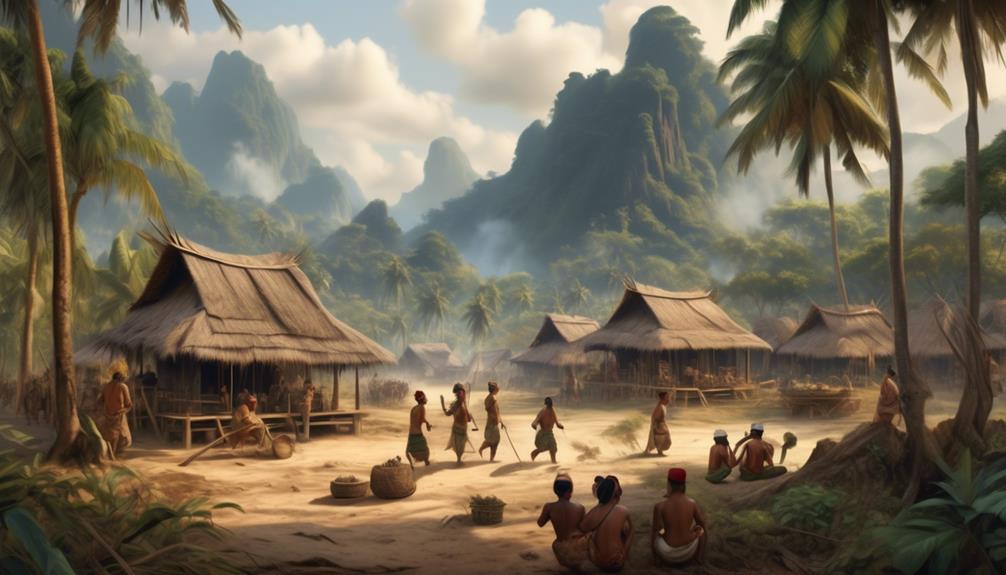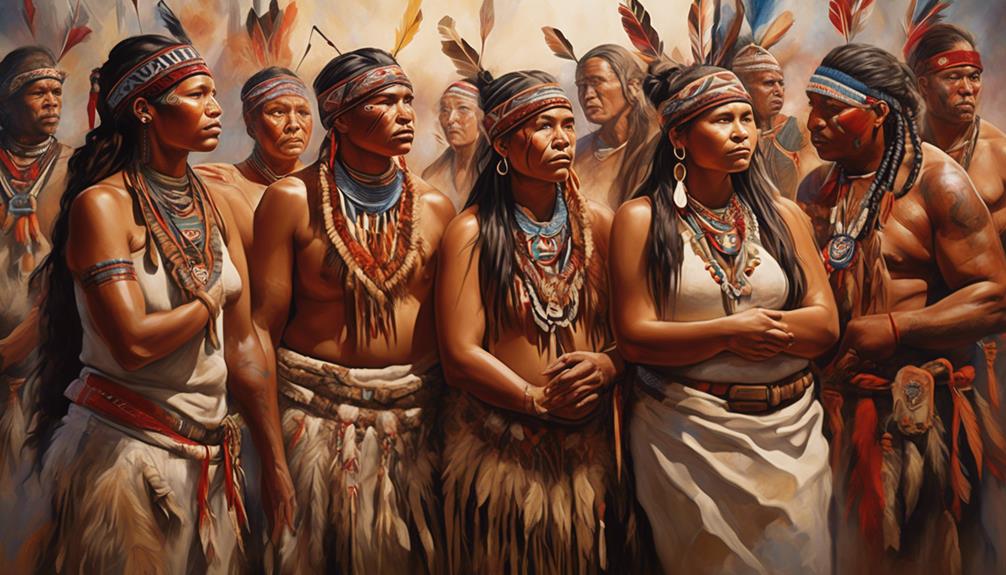As we navigate through the intricate tapestry of history, it is truly remarkable to see how Southeast Asia’s indigenous peoples persevered in the face of colonial rule.
Their response to external domination was as varied as the region's lush landscapes, encompassing resistance, adaptation, collaboration, and the profound impact on their rich cultures.
Understanding these responses not only sheds light on the complexities of colonial encounters but also deepens our appreciation for the enduring spirit of indigenous communities.
The intricate interplay of forces at play during this period unveils a compelling narrative that continues to shape the region to this day.
Key Takeaways
- Indigenous resistance movements in Southeast Asia employed various strategies, including armed resistance and cultural revival efforts, to assert their autonomy and preserve their distinct cultural identities.
- Indigenous communities in Southeast Asia employed economic strategies such as subsistence agriculture, localized trade, and diversification of livelihoods to resist economic exploitation and maintain autonomy.
- Indigenous peoples in Southeast Asia engaged in collaborations and alliances with colonial powers to negotiate limited self-governance and protect their territories while navigating complex colonial governance systems.
- Indigenous cultures in Southeast Asia actively worked to preserve their customs, languages, belief systems, and distinct identities amidst colonial pressures, while also adopting certain aspects of colonial culture and governance structures.
Indigenous Resistance Movements
Indigenous communities across Southeast Asia have organized and participated in a variety of resistance movements in response to colonial rule, utilizing diverse strategies to assert their autonomy and preserve their cultural heritage. These movements have taken various forms, ranging from armed resistance to cultural revival, each reflecting the unique socio-political and historical contexts of the indigenous groups involved.
Armed resistance has been a prominent feature of indigenous responses to colonial rule in certain regions of Southeast Asia. The Acehnese resistance against Dutch colonialism in the 19th and early 20th centuries serves as a striking example. The Acehnese employed guerrilla warfare tactics, fiercely resisting Dutch attempts at subjugation. This armed resistance not only challenged colonial authority but also symbolized a fervent desire to protect their cultural identity and traditional way of life.
In contrast, other indigenous communities have focused on cultural revival as a means of resistance. Through revitalizing traditional practices, languages, and belief systems, these communities have sought to assert their distinct cultural identities in the face of colonial encroachment. For instance, the Dayak people of Borneo have actively engaged in cultural revival efforts, emphasizing the significance of their indigenous knowledge and customs. These movements not only serve as acts of resistance but also as powerful expressions of indigenous resilience and determination in the face of colonial pressures.
Adaptation to Colonial Policies

In navigating the complex web of colonial policies, indigenous communities across Southeast Asia adapted their traditional governance structures and economic systems to meet the demands and challenges imposed by colonial rule. Acculturation played a pivotal role in this adaptation process, as indigenous societies integrated certain aspects of the colonial culture into their own, while also retaining key elements of their traditional ways of life. This process allowed for the preservation of indigenous identities while simultaneously navigating the new colonial landscape.
Governance structures underwent significant modifications as indigenous communities sought to align themselves with colonial expectations. Traditional leadership roles were often reconfigured to fit within the framework of colonial governance, with local leaders collaborating with colonial authorities to maintain a degree of autonomy while also adhering to colonial directives. This adaptive approach enabled indigenous communities to navigate the complexities of colonial rule, demonstrating their resilience and adeptness in responding to external pressures.
Comparatively, different indigenous groups utilized various strategies in adapting to colonial policies, reflecting the diverse ways in which they negotiated their positions within the colonial framework. These adaptations weren't merely reactive, but rather proactive responses aimed at safeguarding indigenous interests while maneuvering within the constraints of colonial rule.
Economic Strategies and Survival
Navigating the complexities of colonial policies, indigenous communities across Southeast Asia adapted their governance structures and economic systems to meet the demands and challenges imposed by colonial rule. In the realm of economic survival, these adaptations took on varied forms and strategies, reflecting the diverse ways in which indigenous groups negotiated their positions within the colonial framework.
- Economic Resistance: Many indigenous communities resisted colonial economic exploitation by engaging in subsistence agriculture and localized trade, thereby maintaining economic autonomy and reducing reliance on colonial markets.
- *Comparison*: Some communities adopted communal land ownership to resist individual land alienation, while others strategically integrated with colonial economies to gain leverage in trade negotiations.
- Survival Strategies: Indigenous groups employed diverse strategies such as diversification of livelihoods, handicraft production, and the preservation of traditional knowledge to ensure economic resilience and cultural continuity in the face of colonial disruptions.
- *Analytical Approach*: By strategically diversifying their economic activities, indigenous communities mitigated the impact of colonial economic policies, ensuring their survival and resilience.
- Adaptive Entrepreneurship: Certain communities embraced entrepreneurial endeavors, such as establishing small-scale businesses or cooperatives, to navigate colonial economic constraints and carve out spaces for economic self-determination.
- *Descriptive Analysis*: This adaptive entrepreneurship enabled indigenous communities to generate income, preserve traditional practices, and assert control over their economic destinies within the colonial context.
Collaboration With Colonial Powers

Despite the challenges posed by colonial powers, many Southeast Asian indigenous communities found strategic ways to engage and collaborate within the colonial framework to protect their interests and secure their autonomy. Collaborative initiatives with colonial powers were often a result of the intricate power dynamics at play during the colonial period.
Indigenous leaders and communities realized that, in order to safeguard their cultural heritage, land rights, and traditional practices, they needed to navigate the complex web of colonial governance. This led to various forms of collaboration, ranging from strategic alliances with sympathetic colonial administrators to negotiations for limited self-governance within the colonial system.
In some instances, indigenous communities utilized their knowledge of local resources and networks to form mutually beneficial partnerships with the colonial authorities. These collaborations allowed for the protection of indigenous territories and enabled communities to retain a degree of autonomy. However, such partnerships were also fraught with power imbalances, where colonial powers often held the upper hand. This necessitated a delicate balancing act for indigenous communities, as they sought to assert their agency while operating within the constraints imposed by colonial rule.
Understanding these collaborative dynamics provides valuable insights into the nuanced strategies employed by indigenous peoples in Southeast Asia to navigate the complexities of colonialism.
Impact on Indigenous Cultures
Utilizing their traditional knowledge and community networks, indigenous cultures in Southeast Asia actively preserved their heritage while adapting to the encroaching influence of colonial powers. The impact of colonial rule on indigenous cultures in Southeast Asia was profound, leading to both cultural preservation and assimilation processes.
- Cultural Preservation
- Indigenous communities upheld their customs, languages, and belief systems, safeguarding their cultural identity amidst colonial pressures.
- Preservation efforts included passing down oral traditions, engaging in traditional craftsmanship, and maintaining spiritual practices, all of which played pivotal roles in cultural continuity.
- Indigenous cultures actively sought to protect their natural resources, sacred sites, and traditional territories from colonial exploitation, further demonstrating their commitment to cultural preservation.
The assimilation processes, on the other hand, involved the adoption of certain aspects of colonial culture and governance structures. This often led to the blending of indigenous traditions with colonial influences, giving rise to new forms of cultural expression and social organization. Despite these adaptations, indigenous cultures tenaciously guarded their core values and customs, striving to maintain their distinct identities in the face of colonial pressures.
Frequently Asked Questions
How Did the Introduction of New Diseases by Colonial Powers Affect the Health and Well-Being of Indigenous Communities in Southeast Asia?
The impact of diseases introduced by colonial powers significantly affected the health and well-being of indigenous communities in Southeast Asia. Indigenous resilience played a crucial role in cultural adaptation to these new health challenges.
However, healthcare disparities persisted, further exacerbating the already vulnerable situation. The introduction of new diseases by colonial powers brought about significant challenges for indigenous communities, highlighting the need for improved healthcare systems and support for these populations.
What Role Did Indigenous Women Play in Resistance Movements Against Colonial Rule in Southeast Asia?
Indigenous women in Southeast Asia played crucial roles in resistance movements against colonial rule. They used traditional trade networks to subvert colonial control, preserving cultural practices and knowledge.
Additionally, they resisted colonial education systems that aimed to erase indigenous identities. Comparatively, their contributions to resistance efforts were vital in shaping the region's history.
Their agency and resilience in the face of colonial oppression demonstrate the strength of indigenous communities in Southeast Asia.
How Did the Arrival of European Colonial Powers Impact the Traditional Trade Networks and Economies of Indigenous Communities in Southeast Asia?
Arriving like a sudden storm, European colonial powers disrupted our traditional trade networks in Southeast Asia.
Our economies had to adapt, weaving new threads into the fabric of our traditions to preserve our cultural resilience. While some aspects of our way of life shifted, we found ways to maintain our identity and heritage.
The impact on trade networks forced us to find new economic strategies, ensuring our survival in the face of colonial rule.
What Strategies Did Indigenous Communities in Southeast Asia Use to Preserve Their Cultural Traditions and Languages in the Face of Colonial Influence?
To preserve their cultural traditions, indigenous communities in Southeast Asia employed diverse strategies, including cultural preservation and language revitalization efforts. These initiatives were crucial in safeguarding their heritage against colonial influence.
By focusing on cultural preservation, communities sought to maintain their distinct identity and resist cultural assimilation. This involved activities such as the preservation of traditional practices, customs, rituals, and art forms. Through these efforts, indigenous communities were able to pass down their cultural knowledge from one generation to the next, ensuring the continuity of their traditions.
Simultaneously, language revitalization played a pivotal role in preserving their linguistic heritage and transmitting it to future generations. Many indigenous languages were at risk of extinction due to the dominance of colonial languages. Language revitalization efforts involved initiatives such as language documentation, language teaching programs, and the creation of language materials and resources. By revitalizing their languages, indigenous communities were able to maintain an integral part of their cultural identity and strengthen their connection to their ancestors.
How Did the Implementation of Colonial Education Systems Affect the Transmission of Indigenous Knowledge and Practices in Southeast Asia?
The implementation of colonial education systems significantly impacted the transmission of indigenous knowledge and practices in Southeast Asia. These systems often aimed to supplant traditional teachings with European-centric curricula, undermining local wisdom. As a result, indigenous communities faced challenges in preserving their cultural heritage and passing down ancestral knowledge.
The shift towards colonial education disrupted the intergenerational transfer of indigenous knowledge, leading to a decline in traditional practices and a loss of cultural identity.
Conclusion
In conclusion, the indigenous people in Southeast Asia responded to colonial rule through a combination of resistance, adaptation, economic strategies, collaboration, and cultural impact.
They fought for their autonomy, adjusted to new policies, developed survival techniques, worked with colonial powers, and experienced changes in their traditional ways of life.
Overall, their responses were complex and multifaceted, reflecting the diverse and dynamic nature of indigenous societies in the region.
Mary is a passionate writer who brings creativity and a fresh perspective to our team. Her words have the power to captivate and inspire, making her an essential contributor to our content. Mary’s commitment to storytelling and dedication to promoting Indigenous culture ensures that her work touches the hearts of our readers. We’re fortunate to have her as part of our team.










